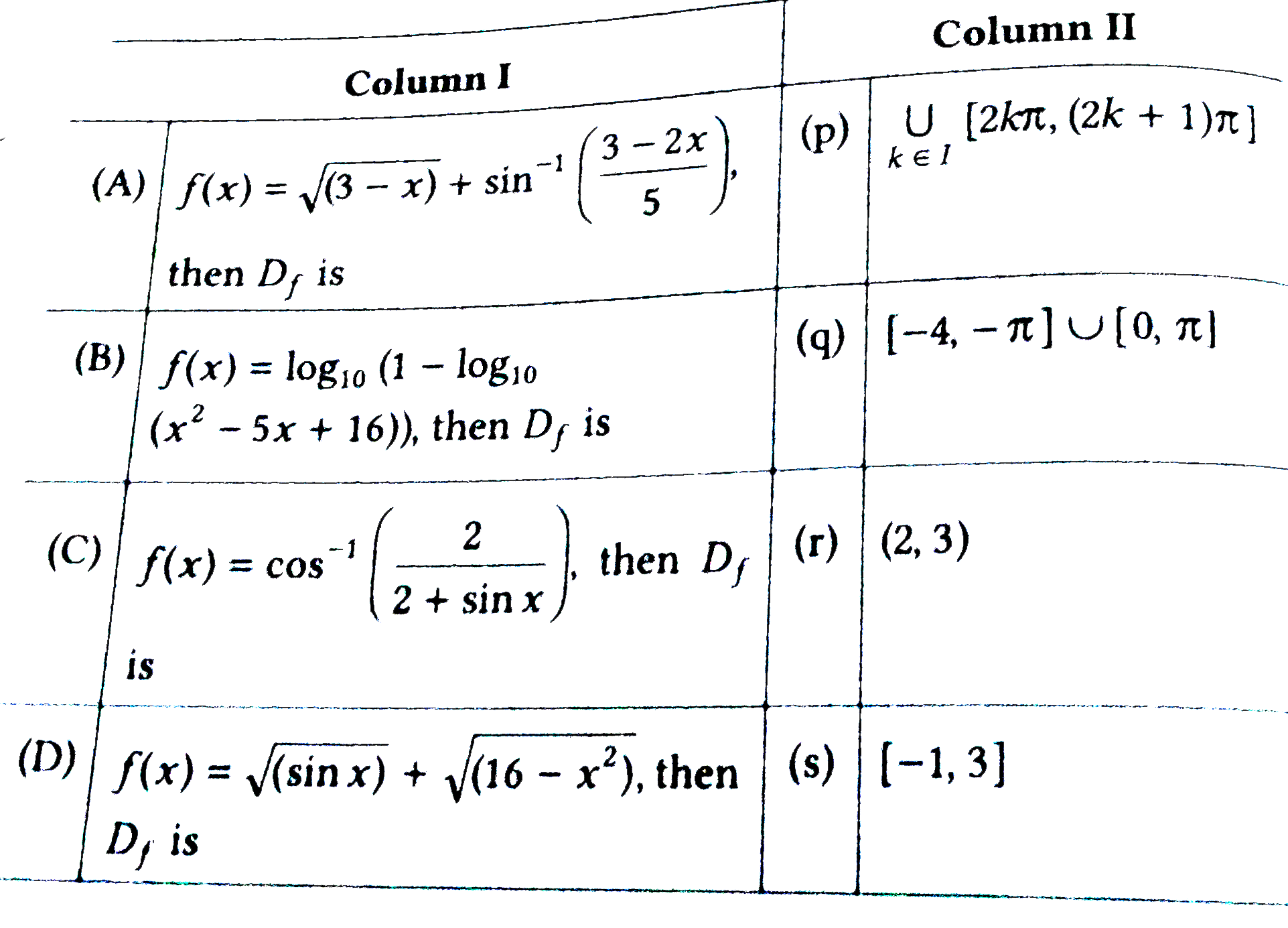The domain of the function f(x) is denoted by Df

Video Solution
Text Solution
The correct Answer is:(A) → (s); (B) → (r); (C ) → (p); (D) → (q)
Let y=√3−x+sin−1(3−2x5)
For y to be defined 3−x≥0 on −1≤3−2x5≤1x≤3 ... (i)
−5≤3−2x≤5
and −1≤x≤4 ... (ii)
From Eqs. (i) and (ii), we get
x∈[−1,3]
(B) Let y=log10 {1−log10(x2−5x+16)} for y to be defined x2−5x+16>0and1−log10(x2−5x+16)>0
(x−52)2+394>0andlog10(x2−5x+16)<1
which is true, ∀x∈R ... (i)
⇒x2−5x+16<10
⇒x2−5x+6<0⇒(x−3)(x−2)<0
⇒2<x<3 ... (ii)
From Eqs. (i) and (ii), x∈(2,3)
(C ) Let y=cos−1.22+sinx, for y to be defined
−1≤22+sinx≤1[∵−1<sinx≤11<2+sinx≤3]
Multiplying by (2+sinx)
−(2+sinx)≤2≤2+sinx
⇒−2−sinx≤2∣2≤2+sinx
⇒.−sinx≤4⇒.sinx≥−4∣∣∣sinx≥02nπ≤x≤(2n+1)π.n∈z ... (i)
We know that sin x∈[−1,1]
∴x∈R ... (ii)
From Eqs. (i) and (ii), x∈[2kπ,(2k+1)π]
Domain ∪k∈I[2kπ,(2k+1π)]
(D) y=√sinx+√16−x2 for y to be defined
sinx≥0x∈[2kπ,(2k+1)π],k∈I ... (i)∣∣∣16−x2≥0−4≤x≤4 ... (ii)
From Eqs. (i) and (ii), we get
x∈[−4,−π]∪[0,π]
|
Updated on:21/07/2023
Topper's Solved these Questions
- BOOK - ARIHANT MATHSCHAPTER - SETS, RELATIONS AND FUNCTIONS EXERCISE - Exercise (Statement I And Ii Type Questions)4videos
SETS, RELATIONS AND FUNCTIONS
- BOOK - ARIHANT MATHSCHAPTER - SETS, RELATIONS AND FUNCTIONS EXERCISE - Exercise (Subjective Type Questions)15videos
SETS, RELATIONS AND FUNCTIONS
- BOOK - ARIHANT MATHSCHAPTER - SETS, RELATIONS AND FUNCTIONS EXERCISE - Exercise (Single Integer Answer Type Questions)5videos
SETS, RELATIONS AND FUNCTIONS
- BOOK - ARIHANT MATHSCHAPTER - SEQUENCES AND SERIESEXERCISE - Exercise (Questions Asked In Previous 13 Years Exam)38videos
SEQUENCES AND SERIES
- BOOK - ARIHANT MATHSCHAPTER - THE STRAIGHT LINESEXERCISE - Exercise (Questions Asked In Previous 13 Years Exam)18videos
THE STRAIGHT LINES
Similar Questions
Knowledge Check
- Question 1 - Select One
The domain of the function f(x)=x is :
ARBR+CR−{0}DR+∪{0} - Question 2 - Select One
The domain of the function f(x)=x is :
ARBR+CR-{0}DR+∪{0} - Question 3 - Select One
The domain of the function f(x)=|x| is :
ARBR+CR−{0}DR+∪{0}

